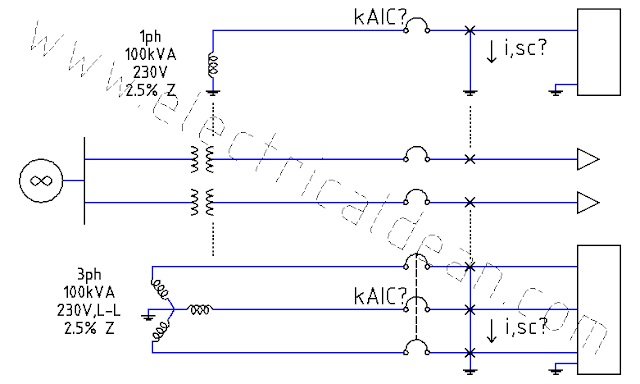Loads - Scenario 2
SITUATION
An impedance coil draws 10 Amps but dissipates only 250W when it is supplied with 220 Volts, 60 Hertz. How much power will it dissipate when it is supplied 110 Volts, 25 Hertz?
ANALYSIS
1.) Existing supply at 220V 60Hz
1.1.) Apparent power:
S<a = P + j Q
S<a = S cos(a) + j S sin(a)
S = V i = 220 * 10 = 2200VA
1.2.) Power factor angle, inductive:
P = S cos(a)
pf = cos(a) = P/S
cos(a) = 250W / 2200VA = 0.1136
a = (+)arccos(0.1136) = 83.48deg
-- Power positive angle means "lagging".
1.3.) Impedance, inductive:
V = i Z
Z = V/i = 220/10 = 22 ohms
Z-> = R + j X
Z-> = Z cos(a) + j Z sin(a)
R = Z cos(a)
R = 22 cos(83.48) = 2.5 ohms
X = Z sin(a)
X = 22 sin(83.48) = 21.86 ohms
1.4.) Inductance at 60Hz:
X = 2 pi f L
L = X / (2 pi f) = 21.86/(2 pi 60)
L = 0.05799H
2.) New supply at 110V 25Hz
2.1.) Reactance at 25Hz:
X = 2 pi f L
X = (2 pi 25) * 0.05799H = 9.11 ohms
2.2.) Resistance remains the same:
R = 2.5 ohms
2.3.) Impedance, inductive:
Z-> = R + j X
Z-> = 2.5 + j 9.11
Z^2 = R^2 + X^2
Z = sqrt(2.5^2 + 9.11^2) = 9.45 ohms
2.4.) Current:
V = i Z
i = V/Z = 110/9.45 = 11.64A
2.5.) Power dissipated:
P = (i^2) R = (11.64^2) * 2.5
P = 338.724W
CONCLUSION
The impedance coil dissipates around 338.7 Watts at 110 Volts, 25 Hertz, while drawing a current of around 11.6 Amps.
An impedance coil draws 10 Amps but dissipates only 250W when it is supplied with 220 Volts, 60 Hertz. How much power will it dissipate when it is supplied 110 Volts, 25 Hertz?
ANALYSIS
1.) Existing supply at 220V 60Hz
1.1.) Apparent power:
S<a = P + j Q
S<a = S cos(a) + j S sin(a)
S = V i = 220 * 10 = 2200VA
1.2.) Power factor angle, inductive:
P = S cos(a)
pf = cos(a) = P/S
cos(a) = 250W / 2200VA = 0.1136
a = (+)arccos(0.1136) = 83.48deg
-- Power positive angle means "lagging".
1.3.) Impedance, inductive:
V = i Z
Z = V/i = 220/10 = 22 ohms
Z-> = R + j X
Z-> = Z cos(a) + j Z sin(a)
R = Z cos(a)
R = 22 cos(83.48) = 2.5 ohms
X = Z sin(a)
X = 22 sin(83.48) = 21.86 ohms
1.4.) Inductance at 60Hz:
X = 2 pi f L
L = X / (2 pi f) = 21.86/(2 pi 60)
L = 0.05799H
2.) New supply at 110V 25Hz
2.1.) Reactance at 25Hz:
X = 2 pi f L
X = (2 pi 25) * 0.05799H = 9.11 ohms
2.2.) Resistance remains the same:
R = 2.5 ohms
2.3.) Impedance, inductive:
Z-> = R + j X
Z-> = 2.5 + j 9.11
Z^2 = R^2 + X^2
Z = sqrt(2.5^2 + 9.11^2) = 9.45 ohms
2.4.) Current:
V = i Z
i = V/Z = 110/9.45 = 11.64A
2.5.) Power dissipated:
P = (i^2) R = (11.64^2) * 2.5
P = 338.724W
CONCLUSION
The impedance coil dissipates around 338.7 Watts at 110 Volts, 25 Hertz, while drawing a current of around 11.6 Amps.





Comments
Post a Comment